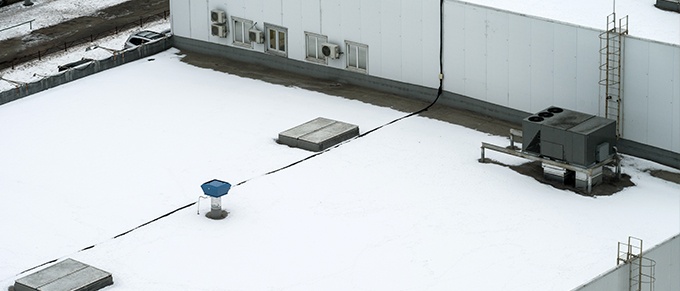How Snow and Ice Impact Your Flat Roof
Many commercial buildings have flat roofs to accommodate mounted HVAC systems. While we call the roof flat, there is still a slight pitch to direct water off of the roof so that it does not pond on the surface and rot out the roof. Yet when you add the extra element of wind, the roof can sustain enough damage to allow moisture to get underneath the felt sheets, bitumen, or EPDM roofing materials.
Start with a commercial roof inspection before winter weather comes (sometime in the fall is the best time to do this), and check for areas where the seal between strips of commercial roofing material might becoming loose, signs of standing water or water damage, or things like rusted flashing and metal fasteners.
It doesn’t take much wind to cause significant damage to flat commercial roof systems. A damaged commercial roof can lead to building damage, endanger the people working or shopping in the building, and put your company at risk for significant structural damage and lost productivity if it collapses or becomes damaged during the winter months. Avoid these potential disastrous scenarios by preparing your commercial roof for the unique challenges of winter weather.
Snow Buildup how to deal with snow on flat roof
South East winters often include snowstorms, and a build-up on your roof can cause major damage. Most commercial roofing is flat, making it a perfect surface area for the buildup of snow, but commercial buildings also have a maximum weight limit, and heavy snow and drifts can put a dangerous level of stress on your roof’s structural integrity. In a previous post, we discuss the dangers of snow load, and how a comprehensive roof maintenance plan can help protect your buildings year-round.
Ice Dams flat roof snow melt
Another hazard of the winter months is ice dams. Ice dams sometimes occur on sloping roofs in climates with freezing temperatures. When the temperature in your attic is above freezing, it causes snow on the roof to melt and run down the sloping roof. When the snowmelt runs down the roof and hits the colder eaves, it refreezes. If this cycle repeats over several days, the freezing snowmelt builds up and forms a dam of ice, behind which water ponds. The ponding water can back up under the roof covering and leak into the attic or along exterior walls. The right weather conditions for effects of snow on is usually when outside air temperatures are in the low 20s (°F) for several days with several inches of snow on the roof.
Condensation
When warm air meets a cold surface, condensation will occur. Additionally, inadequate ventilation can damage your roof, the decking, and encourage ice dams and shorten your roof’s overall lifespan by half. Excess water in the area of the roofing materials can also lead to damage, particularly around the seams, so be sure to inspect your commercial roofing regularly and work with your commercial roofing contractor to get the proper ventilation and other systems in place to minimize this type of damage.
Frequently Question Ask
- Can snow damage a flat roof?
- How does snow and ice affect your roof?
- How do you manage snow on a flat roof?
- How much snow load can a flat roof handle?


